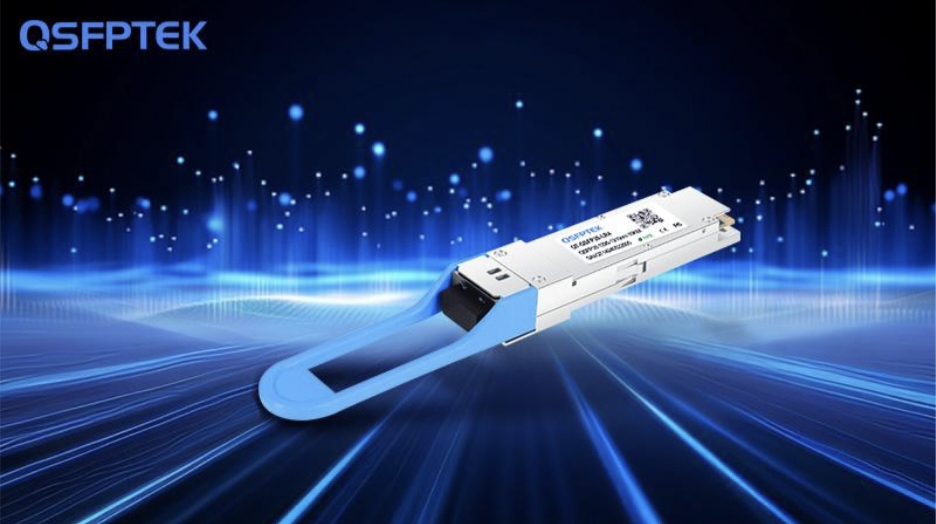In today’s rapidly evolving digital landscape, cloud services and data centers are the backbone of many industries, providing essential infrastructure for everything from e-commerce to machine learning. As data consumption continues to grow exponentially, the need for high-speed, reliable connectivity between data centers is more critical than ever. One of the key enablers of this next-generation interconnectivity is the 100G QSFP28 module, which offers a high-bandwidth, long-distance solution ideal for cloud providers and large-scale data center networks. This article will explore how the 100G QSFP28 LR4 optical module facilitates seamless interconnectivity between data centers and cloud platforms, addressing the increasing demands for data exchange and real-time services.

Understanding the Role of 100G QSFP28 LR4 in Cloud and Data Center Networks
The 100G QSFP28 LR4 optical transceiver operates over 1310nm wavelength, supporting data transmission distances up to 10 kilometers over single-mode fiber (SMF). This combination of high-speed and long-distance capabilities makes it an ideal solution for interconnecting data centers that span vast geographical distances. Whether for cloud service providers, telecommunications companies, or large enterprises, the ability to transmit large volumes of data efficiently and reliably is paramount.
One of the most significant advantages of the QSFP28 100G LR4 is its ability to deliver 100 Gbps of bandwidth, providing ample capacity for the increasing demands of cloud services. With cloud platforms hosting vast amounts of data, offering software-as-a-service (SaaS), and delivering machine learning and artificial intelligence (AI) capabilities, the 100G QSFP28 LR4 helps ensure that data is transferred quickly and efficiently, even in high-traffic, high-demand environments.
Meeting the Growing Demand for Data Exchange
As cloud services continue to expand, so does the volume of data that must be exchanged between data centers. For example, enterprises increasingly rely on hybrid cloud architectures, where their on-premise infrastructure is seamlessly connected to cloud platforms to improve scalability, flexibility, and disaster recovery. The 100G QSFP28 LR4 optical module plays a pivotal role in these architectures, ensuring that data can be transferred quickly between cloud regions or between a data center and its cloud providers, even across long distances.
This high-capacity module enables more efficient inter-data center communication, where the speed and bandwidth of the connection directly impact the overall performance of cloud services. For example, big data analytics, real-time video streaming, and AI workloads require large amounts of data to be transmitted between data centers. With 100G QSFP28 LR4, these high-bandwidth applications can run smoothly, providing customers with faster processing and lower latency, which are essential for time-sensitive workloads.
Supporting Seamless Data Center Interconnection
One of the main challenges for large-scale cloud services and data centers is ensuring seamless, high-speed interconnection between facilities, particularly when they span multiple cities or even countries. Data centers often need to exchange vast amounts of data between locations to maintain business continuity and provide efficient services to their clients. The 100G QSFP28 LR4 optical module addresses this challenge by offering long-range transmission over single-mode fiber, making it an excellent solution for data center interconnection (DCI) over large distances.
For example, large cloud providers such as Amazon Web Services (AWS) and Google Cloud operate massive global networks of data centers that must be interconnected to provide services with minimal latency and maximum reliability. The 100G QSFP28 LR4 enables these providers to link their data centers across vast distances, supporting a seamless flow of data between them. This ensures that workloads, applications, and services hosted in different geographical regions can communicate efficiently, without bottlenecks or interruptions in service.
With 100G QSFP28 LR4, data can be transferred with low latency, which is crucial for real-time applications like video conferencing, financial trading, and cloud gaming. Low latency is essential to providing a smooth, responsive experience for end-users, which is why cloud service providers and data center operators place great importance on using high-performance modules like the 100G QSFP28 LR4.
Enhancing Cloud Provider Efficiency and Scalability
Cloud providers need to scale their infrastructure rapidly to meet the increasing demands for computing power, storage, and processing. As workloads grow, the need for high-capacity, low-latency interconnection between data centers also increases. The 100G QSFP28 LR4 optical module supports this need by offering scalability in terms of both bandwidth and distance. This allows cloud providers to expand their networks without the need for frequent upgrades or major overhauls.
In addition to scalability, the 100G QSFP28 LR4 helps cloud providers maintain high availability and redundancy across their networks. By connecting data centers in different geographic locations, service providers can ensure that, in the event of a failure at one site, data can quickly be rerouted to another site without service disruption. This contributes to the resilience of the network, a critical requirement for cloud services that must operate continuously.
The ability of the 100G QSFP28 LR4 to support long-distance connections also facilitates the expansion of cloud data centers into emerging markets. For example, cloud service providers can extend their networks into new regions with fewer constraints on distance, offering their services to clients in more remote areas while maintaining a high-quality user experience.
Future-Proofing Data Center Networks with 100G QSFP28 LR4
As data centers continue to evolve and future technologies like 5G, Internet of Things (IoT), and edge computing become more prominent, the demands on network capacity will only continue to grow. The 100G QSFP28 LR4 offers a future-proof solution, supporting 100 Gbps speeds and long-range transmission. This enables data center operators and cloud service providers to stay ahead of the curve as new technologies emerge, ensuring that their networks can handle the ever-expanding data traffic.
Moreover, as 100G technology becomes more ubiquitous, the 100G QSFP28 LR4 module will continue to play a crucial role in supporting the high-speed interconnectivity needed to power next-generation networks. It provides a reliable, cost-effective solution for cloud providers and data centers that need to ensure fast, secure, and seamless communication between their facilities.
Conclusion
The 100G QSFP28 LR4 optical module is an essential component for large-scale cloud service providers and data centers seeking high-bandwidth, long-distance connectivity. By offering 100 Gbps of bandwidth over single-mode fiber with low latency and a transmission range of up to 10 kilometers, it helps meet the growing data exchange demands of modern cloud platforms. This module enables seamless interconnection between geographically dispersed data centers, supporting the increasing demands of real-time applications, data analytics, and AI workloads.
As the need for faster, more efficient cloud services continues to rise, the 100G QSFP28 LR4 is poised to play a critical role in shaping the future of data center interconnection, helping to create more resilient, scalable, and efficient networks that can keep up with the ever-growing digital economy.




